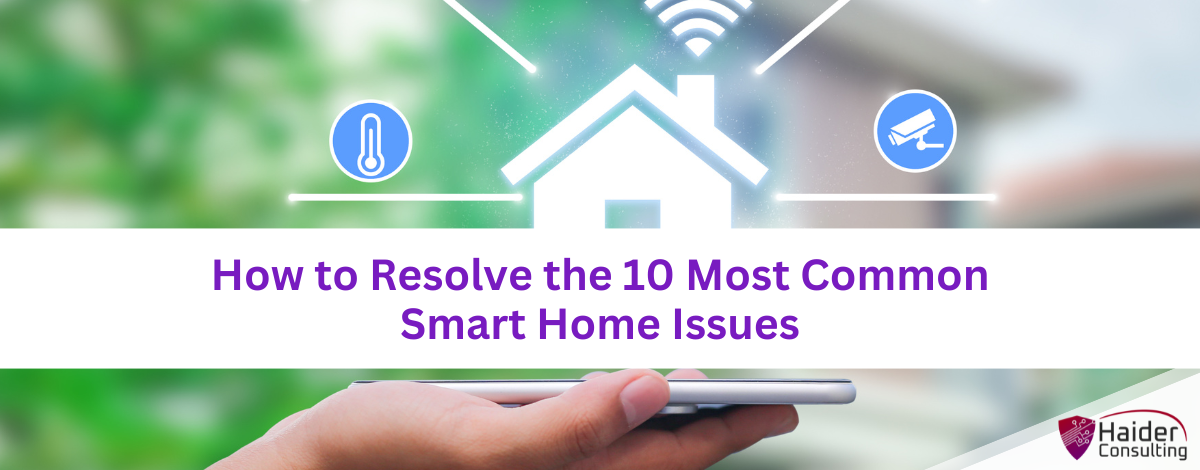As a kid, the idea of a “smart home” might have seemed like something straight out of a sci-fi movie. While we may not have flying cars yet, we do have video calls, smart fridges, and voice-controlled lights.
However, even cutting-edge tech can run into simple problems. Hackers can break in through weak passwords, and poor connections can reduce your high-tech gear to basic functions.
Running into problems with your smart home devices? Don’t worry! We’re here to help you fix some of the most common smart home issues.
Common Smart Home Issues and How to Fix Them
Here are some typical problems you might face, along with easy solutions to help get your smart home running smoothly again.
1. Connectivity Problems
Are your smart devices not connecting to Wi-Fi? Smart gadgets are great because they work wirelessly and connect to a smart home hub via the internet. But that also means it’s a hassle if they won’t connect.
If you’re having trouble with connections, start with simple fixes. Restart your router and your devices. If that doesn’t help, check the position of your router. It should be in the middle of your home for the best signal. For larger homes, think about getting a mesh network system or a Wi-Fi extender to improve coverage.
2. Device Unresponsiveness
It’s also frustrating when voice-activated devices don’t respond to their “wake word.” If you find yourself shouting commands with no response, try a simple fix first. Turn the device off and then back on. Also, check for and install any software updates for your device and its apps. Updates can fix glitches and improve how well your device works.
3. Battery Drain
Battery-powered smart devices can run out of power quickly. To save battery life, change the settings to use less power. Turn off features you don’t need, like flashy notification lights or continuous background updates. Also, consider using high-quality batteries for better performance.
4. Incompatibility Issues
It’s important to remember that smart devices aren’t always compatible with each other, even if they are labeled as “smart.” If a new device doesn’t work with your existing setup, it can be a waste of money.
To prevent this, always check if new devices will work with the ones you already have before buying them. Choose devices that fit with the smart home system you use, and read the manufacturer’s details carefully to avoid issues with compatibility.
5. Security Concerns
Security is crucial for a smart home, especially with increasing reports of devices like baby monitors being hacked. It’s important to secure your devices properly instead of just rushing to set them up.
Here’s how you can protect your smart home:
- Use strong, unique passwords for each device and account.
- Turn on two-factor authentication when possible.
- Regularly update your devices and apps to receive the latest security patches.
Additional tips for securing your smart devices include:
- Rename your devices with generic names rather than using the defaults.
- Connect your smart devices to a separate guest network. This isolates them from your main devices that hold sensitive information.
- Disable any sharing settings that you don’t need, as these are often automatically turned on.
6. App Troubles
Encountering random bugs or glitches? The issue might be with the app. Ensure you have the latest updates installed. Logging out and back into the app can also help refresh its settings. If the problem continues, try uninstalling and reinstalling the app.
7. Automation Gone Wrong
Smart home automation is meant to make life easier, but it can sometimes act up. So, double-check your automation settings, making sure everything has the correct configuration. Test each automation separately to pinpoint any that aren’t working as they should.
8. Limited Range
Some smart devices can only work within a certain distance. Check the manufacturer’s instructions to understand their range. If needed, move your devices closer to your hub or router to improve their connection. You might also want to consider adding repeaters or extenders if they’re too far away.
9. Ghost Activity
Have your smart lights ever turned on or off by themselves? This might happen because of:
- Accidental voice commands.
- Faulty sensors.
- Automations you’ve set and forgotten.
- A possible security breach.
Go through your automation settings and turn off any you don’t use. Make sure your devices aren’t mistakenly picking up voice commands meant for something else. Also, update your passwords and stay alert for any signs of hacking.
10. Feeling Overwhelmed
Managing multiple smart devices can sometimes be too much. If you find yourself struggling, look at the manuals that came with your devices or search online for help. You can also reach out to IT professionals for specific advice and troubleshooting tips.
Need Help Securing Your Smart Home Devices?
Your smart home should make things easier, not harder. The tips mentioned can help you solve common problems. But if you use any of this tech in the office, it’s also wise to have a security assessment and ensure it’s safe.
Call us today to arrange a security checkup for your office smart gadgets and feel more secure.
Book My 17-Minute Call





